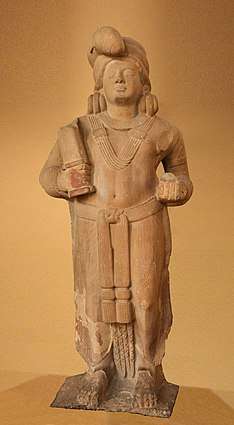Mudgar
A Mudgar is a type of "Gada" mace from India, and it is generally considered to be made of wood, but can also be made of iron.[3]
Mathura, 100 BCE
Usage
The mudgar appears is ancient Indian sculptures, where it is commonly held Yaksha deities, known as "Mudgarpanis" (Mudgar-holders).[4]
An ancient Jain story named the Antagadadasao tell the story of a man named Ajjunaka who was worshipping the image of the "Yaksa who held a mace", when he was attacked by five bandits, an event which shaked is devotion to the Yashka. Afterwards the Yaksa possessed Ajjunaka, giving him the strength to kill the five bandits.[5]
Nowadays, for training purposes when using Indian clubs, one or two wooden gada ("mudgar"), reaching up to 70 kilograms in weight, can be used: they can be swung behind the back in several different ways; this is particularly useful for building grip strength and shoulder endurance.[6][7]
Examples
- Yaksha holding mudgar and child. Art of Mathura, 100 BCE.[8]
See also
References
- Dated 100 BCE in Fig.88 in Quintanilla, Sonya Rhie (2007). History of Early Stone Sculpture at Mathura: Ca. 150 BCE - 100 CE. BRILL. p. 368, Fig. 88. ISBN 9789004155374.
- Fig. 85 in Quintanilla, Sonya Rhie (2007). History of Early Stone Sculpture at Mathura: Ca. 150 BCE - 100 CE. BRILL. p. Fig.85, p.365. ISBN 9789004155374.
- Bulletin of the Victoria Memorial. Trustees of the Victoria Memorial. 1973. p. 49.
- Handa, Devendra; Agrawal, Ashvini (1989). Ratna-chandrikā: Panorama of Oriental Studies : Shri R.C. Agrawala Festschrift. Harman Publishing House. p. 90. ISBN 978-81-85151-29-8.
- Sharma, Ramesh Chandra (1994). The Splendour of Mathurā Art and Museum. D.K. Printworld. p. 76. ISBN 978-81-246-0015-3.
- Kasulis, Thomas P.; Aimes, Roger T.; Dissanayake, Wimal (1993). Self as Body in Asian Theory and Practice. SUNY Press. ISBN 9780791410806.
- "Mudgar exercise-club". British Museum. Retrieved 2019-02-01.
- Dated 100 BCE in Fig. 85 Quintanilla, Sonya Rhie (2007). History of Early Stone Sculpture at Mathura: Ca. 150 BCE - 100 CE. BRILL. p. Fig.85, p.365. ISBN 9789004155374.
